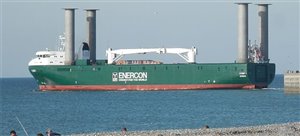We could greatly reduce the fuel consumption and emissions of ships if we used the energy of waves. This could done by adding a pipe all the way around the ship above sea level. Water enters the pipe at the bow and exits at the stern to push the ship forward. The pipe is higher and wider at the bow than the stern. Waves force water into one way openings at the bow to give pressurised water with potential energy. This pressurised water forces jets of water out at the stern.
All the pipework is above sea level so ships could be retroftted without the need to go into dry docks. There is no change to the laminar flow of water below sea level.
The motion of the ship adds to the kinetic energy of waves. By diverting this energy around the ship we can reduce drag and fuel consumption. This would be a low cost way to reduce greenhouse gas emissions without the need for people to reduce their standards of living.
